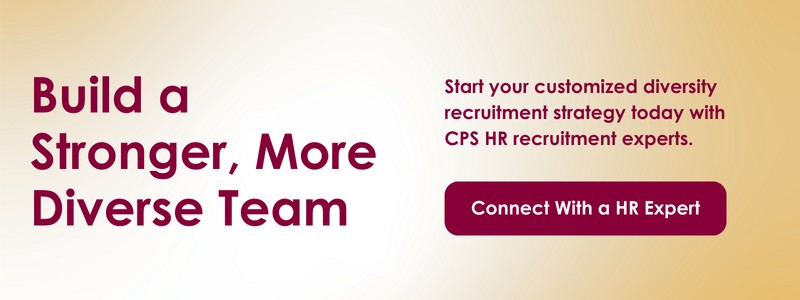Table of Contents
What Does it Mean to Have Diversity in Recruitment?
Diversity in recruitment means creating hiring processes that attract, evaluate, and select candidates from a wide range of backgrounds, experiences, and perspectives, considering factors such as race, gender, age, ethnicity, disability, sexual orientation, and socioeconomic status. The goal is to provide equitable opportunities for all candidates and mitigate biases that limit access for underrepresented groups. Many types of diversity should be considered, including both visible and invisible differences.
What You Need to Know About Diversity Hiring
The diversity hiring rule – often referred to as the “Rooney Rule” – requires employers to interview a diverse slate of candidates for open positions, particularly focusing on underrepresented groups. This helps organizations overcome unconscious biases and ensures that qualified individuals from diverse backgrounds are given fair consideration. While requirements vary by location and industry, the core principle remains the same: Hiring strategies should be made to identify and evaluate talent from diverse sources.
Diversity hire requirements typically focus on creating fair and inclusive recruitment processes rather than establishing rigid quotas. These requirements may include practices such as:
- Diverse interview panels
- Standardized assessment criteria
- Unbiased job descriptions
Organizations may also be required to document their diversity efforts, demonstrate attempts to recruit from underrepresented groups, and maintain transparency in their hiring decisions. The goal is to remove barriers that might prevent qualified candidates from accessing opportunities, not to prioritize diversity over merit.
Why is Diversity in Recruitment Important?
1. Encourages Innovation and Creativity
When teams are made up of people from different backgrounds and experiences, they naturally come up with more innovative ideas and solutions. Studies consistently show that diverse teams are more likely to challenge assumptions, explore alternative viewpoints, and find creative ways to solve complex problems. This mix of perspectives is a significant competitive advantage. Having different viewpoints means problems are tackled from multiple angles. People with diverse experiences bring insights that might otherwise be missed, helping organizations:
- Spot blind spots
- Predict potential challenges
- Create more well-rounded strategies for success
2. Attracts Top Talent
Having clear commitment to diversity attracts a wider pool of qualified job seekers that may otherwise have not applied. When candidates see people like themselves thriving within your organization, they are more likely to see opportunities for their own growth and development.
A positive reputation in diversity goes beyond just recruitment and also shapes how customers, partners, and investors view your company.
3. Enhances Employee Engagement and Retention
Employees who feel valued for their unique contributions and perspectives demonstrate higher levels of engagement and job satisfaction. Inclusive workplaces foster a sense of belonging that encourages team members to share ideas, take appropriate risks, and invest in the organization’s success. This engagement translates to higher productivity, better customer service, and stronger team collaboration.
By reducing turnover, companies save significant resources in recruitment, onboarding, and training while preserving valuable institutional knowledge and team cohesion.
4. Encourages Equal Opportunity
Diversity focused recruitment practices ensure that all qualified candidates are fairly considered, regardless of their background or identity. By using structured processes that focus on skills and potential rather than demographic characteristics, organizations create more equitable opportunities for underrepresented groups.
Effective diversity strategies help eliminate systemic barriers such as biased language in job descriptions, limited recruitment channels, and subjective evaluation criteria. By addressing these issues, companies not only comply with equal opportunity regulations but also build stronger, more representative teams.
8 Strategies to Help with Diversity in Recruitment
1. Review and Revise Job Descriptions
Job descriptions serve as potential candidates’ first impressions of your organization and role expectations. Unfortunately, many job postings contain unconsciously exclusive gender-coded language or unnecessary requirements that discourage diverse applicants.
To improve your job descriptions:
- Review postings for biased terms (eg. “aggressive,” “competitive,” or “dominant”)
- Replace biased or exclusive language with inclusive alternatives
- Focus on essential skills and competencies rather than rigid experience or education requirements
- Be flexible about years of experience to accommodate non-linear career paths
2. Expand Recruitment Channels
Relying on the same recruitment sources often leads to similar candidate pools. By partnering with diverse job boards, professional associations, and community organizations, you can reach qualified candidates from underrepresented groups. Consider platforms like Diversity.com, the Hispanic/Latino Professionals Association, the Black Career Network, or Pink Jobs to connect with diverse talent that might not typically engage with your usual recruitment channels.
Attending specialized career fairs focused on underrepresented groups gives you the chance to engage directly with diverse candidates. Universities with diverse student bodies, professional associations for women in technology or engineering, and organizations supporting veterans or people with disabilities often host recruitment events. These venues not only allow you to demonstrate your commitment to inclusion but also help you build relationships with potential candidates who may not have previously considered your organization.
3. Implement Blind Hiring
It is not uncommon for resumes with applicant names that are perceived to be from a non-white ethnicity to receive significantly fewer callbacks, even when qualifications are nearly identical. This unfortunate systemic bias is also common when considering factors like an applicants gender, age group, educational background, and more.
Blind hiring techniques – where details like names, addresses, graduation years, and photos are hidden during initial review – allow recruiters to focus solely on qualifications and potential. Removing these identifiers from resumes and applications helps minimize potential unconscious bias in initial screening that may otherwise prevent the best true hire from being chosen.
Structured skills assessments offer objective ways to measure candidates’ abilities, reducing reliance on subjective impressions. Work sample tests, job-related simulations, and technical evaluations allow all candidates to showcase their skills, regardless of their background. To ensure fairness and validity, these assessments should be standardized for all applicants and directly tied to essential job functions.
4. Standardize Interviews
Unstructured interviews can lead to inconsistent evaluations and increased bias. Asking all candidates the same set of questions in the same order helps level the playing field and provides comparable data for decision-making. Behavior-based questions, which ask candidates how they handled specific situations in the past, are more reliable than hypothetical or general questions.
It’s also important to train interviewers to recognize and reduce their own unconscious biases to make diversity recruitment more effective. This training should cover common biases like:
- Affinity bias (preferring people similar to ourselves)
- Halo/horn effect (letting one positive or negative trait influence overall perception)
- Confirmation bias (seeking information that confirms existing beliefs)
Interviewers should also learn techniques for focusing on job-relevant criteria and making evidence-based assessments rather than “gut feelings.”
5. Track Diversity Metrics
You can’t improve what you don’t measure. Tracking recruitment and hiring data helps pinpoint patterns, bottlenecks, and areas for improvement in your diversity efforts. Key metrics might include the demographic composition of applicant pools, interview panels, and final hires; conversion rates at each stage of the recruitment process; and retention rates across diverse employee groups. This data gives you valuable insights into where diverse candidates might be dropping out of your pipeline.
Setting specific, measurable goals turns diversity from an abstract concept into a clear business objective. Instead of vague goals like “increase diversity,” aim for targets such as “increase the representation of women in leadership roles by 15% within two years” or “ensure interview slates include at least two qualified candidates from underrepresented groups.” These clear goals create accountability and help you assess the impact of your diversity initiatives over time.
6. Strengthen Employer Branding
Your public communications send strong signals about your organization’s values and culture. Featuring diversity initiatives, employee resource groups, and inclusive policies on your careers page and social media shows a true commitment to inclusion. Highlight diverse leadership and team members (with their permission) to help potential applicants picture themselves thriving within your company.
Personal stories are more impactful than corporate statements. Sharing testimonials from diverse employees about their experiences, growth opportunities, and sense of belonging gives authentic insights that candidates trust. These stories should reflect real experiences, not scripted messages, as job seekers are becoming more skilled at spotting performative diversity claims versus genuine efforts.
7. Develop Internships & Mentorships
Targeted internship programs create opportunities for diverse candidates who may not have access to an industry or organization otherwise. Partnering with historically Black colleges and universities (HBCUs), Hispanic-serving institutions, or community colleges can help identify promising talent early in their careers.
These programs should offer:
- A meaningful work experience
- Competitive compensation
- Clear pathways to full-time employment for successful participants
Formal mentorship initiatives also support the development and advancement of diverse employees once they are hired. Pairing new team members with experienced mentors enables them to navigate the organizations culture, build professional networks, and access growth opportunities. Effective mentorship programs have clear goals, regular check-ins, and resources for both mentors and mentees. When designed thoughtfully, these programs help diverse employees prepare for and fulfill prominent roles and duties.
8. Encourage Diverse Referrals
Employee referrals often bring in high-quality candidates, but they can also reinforce homogeneity if employees mainly refer people from similar backgrounds. Offering specific incentives for diverse referrals encourages employees to broaden their networks. Some organizations provide enhanced referral bonuses for candidates from underrepresented groups or recognize employees who help meet diversity goals.
While referrals are a valuable recruitment tool, it’s important that all candidates—whether referred or not—go through the same unbiased evaluation process. This ensures that referral programs promote diversity rather than unintentionally favoring certain candidates. Setting clear criteria for advancing through the hiring process helps maintain fairness while leveraging employees’ networks to identify diverse talent.
Build a Stronger, More Diverse Team
Effective diversity recruitment isn’t just about meeting quotas or checking boxes. It’s about creating inclusive processes that identify and develop the best talent from all backgrounds. By implementing strategies like unbiased job descriptions, expanded recruitment channels, structured interviews, and meaningful metrics, organizations can build teams that reflect the rich diversity of their customers and communities.
A more diverse team will ultimately drive innovation, enhance decision-making, and deliver stronger business results.
Connect with a professional today for expert assistance developing a customized diversity recruitment strategy for your organization.


